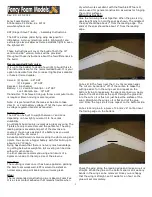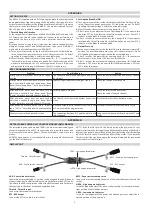
COOLING (cont.)
E. Special Servicing Procedures
The air conditioning system should be serviced by a qualified shop with trained personnel. The follow-
ing procedures and precautions should be observed.
The efficiency of this system depends upon the pressure-temperature relationship of pure refrigerant.
As long as the system contains only pure refrigerant plus a specified amount of compressor oil (which
is mixed with the refrigerant), it is considered to be chemically stable. Foreign materials within the
system will affect the chemical stability, contaminate the system, and decrease its efficiency.
F General Refrigeration System Procedures
(1) Refrigerant Safety Precautions
(a) Refrigerant 12 (commonly known as R-12 (or Freon 12) is odorless and colorless in either
the liquid or gaseous state. R-12 for charging refrigeration systems is supplied in pressur-
ized containers (approx. 70 psi at 70 F in liquid form). Since this material is essentially inert
at room temperatures the dangers are primarily associated with the pressure and the refrigera-
tion effects of the release and subsequent evaporation of this pressurized liquid.
(b) Wear suitable eye protection when handling R-12 due to the possibility of freezing of the eye
if contacted by escaping liquid refrigerant. If liquid R-12 does strike the eye, the following
actions should be taken:
1 DO NOT RUB THE EYE.
2 Splash large quantities of cool water into the eye to raise the temperature.
3 Tape on an eye patch to avoid the possibility of dirt entering the eye.
4 Rush to a physician or hospital for immediate professional aid.
5 DO NOT ATTEMPT TO TREAT IT YOURSELF.
(c) If liquid R-12 strikes the skin frostbite can occur. Treat with cool water and protect with
petroleum jelly.
(d) Do not discharge large quantities of R-12 into closed rooms. It may displace most of the air
in the room and this could cause oxygen starvation. Gaseous R-12 is heavier than air and
flows to the bottom of a container.
(e) Do not discharge R-12 into an open flame or onto a very hot surface (500F). Poisonous phos-
gene gas is generated by the action of the heat on the refrigerant.
(f) Do not apply direct flame or other high heat source to a R-12 container due to the high
pressures which will result. If any heating is done to R-12 containers the container pressure
should be monitored and kept below 150 psi.
(2) System Servicing Precautions
— CAUTION —
Environmental regulations may require use of a collection
system when necessary to evacuate freon from system
(a) Systems should be discharged slowly to prevent the escape of liquid refrigerant and the loss
of the lubrication oil.
(b) Systems should not be left open to the atmosphere when discharged. Moisture and other con-
tamination may enter and damage open systems.
(c) Never introduce anything but pure refrigerant and refrigerant oil into a system.
PIPER AIRCRAFT
PA-32R-301/301T
MAINTENANCE MANUAL
21-50-00
Page 21-18
Reissued: July 1, 1993
1I1
Summary of Contents for PA-32R-301T SARATOGA S
Page 26: ...CHAPTER 4 AIRWORTHINESS LIMITATIONS 1C1 ...
Page 29: ...CHAPTER 5 TIME LIMITS MAINTENANCE CHECKS 1C4 ...
Page 53: ...CHAPTER 6 DIMENSIONS AND AREAS 1D6 ...
Page 64: ...CHAPTER 7 LIFTING AND SHORING 1D21 ...
Page 68: ...CHAPTER 8 LEVELING AND WEIGHING 1E1 ...
Page 72: ...CHAPTER 9 TOWING AND TAXIING 1E5 ...
Page 76: ...CHAPTER 10 PARKING AND MOORING 1E9 ...
Page 80: ...CHAPTER 11 REQUIRED PLACARDS 1E13 ...
Page 92: ...CHAPTER 12 SERVICING 1F1 ...
Page 126: ...CHAPTER 20 STANDARD PRACTICES AIRFRAME 1G17 ...
Page 127: ...THIS PAGE INTENTIONALLY LEFT BLANK ...
Page 139: ...CHAPTER 21 ENVIRONMENTAL SYSTEMS 1H5 ...
Page 188: ...CHAPTER 22 AUTOFLIGHT 1J7 ...
Page 193: ...CHAPTER 23 COMMUNICATIONS 1J12 ...
Page 203: ...CHAPTER 24 ELECTRICAL POWER 1J22 ...
Page 263: ...CHAPTER 25 EQUIPMENT FURNISHINGS 2A13 ...
Page 269: ...CHAPTER 27 FLIGHT CONTROLS 2A20 ...
Page 332: ...CHAPTER 28 FUEL 2D11 ...
Page 363: ...CHAPTER 29 HYDRAULIC POWER 2E18 ...
Page 404: ...CHAPTER 30 ICE AND RAIN PROTECTION 2G16 ...
Page 470: ...CHAPTER 32 LANDING GEAR 3A13 ...
Page 550: ...CHAPTER 33 LIGHTS 3D24 ...
Page 562: ...CHAPTER 34 NAVIGATION AND PITOT STATIC 3E12 ...
Page 582: ...CHAPTER 35 OXYGEN 3F8 ...
Page 604: ...CHAPTER 37 VACUUM 3G6 ...
Page 616: ...CHAPTER 39 3G18 ELECTRIC ELECTRONIC PANELS MULTIPURPOSE PARTS ...
Page 620: ...CHAPTER 51 STRUCTURES 3G22 ...
Page 636: ...CHAPTER 52 DOORS 3H14 ...
Page 650: ...CHAPTER 55 STABILIZERS 3I4 ...
Page 662: ...CHAPTER 56 WINDOWS 3I16 ...
Page 670: ...CHAPTER 57 WINGS 3I24 ...
Page 688: ...CHAPTER 61 PROPELLER 3J18 ...
Page 704: ...CHAPTER 70 STANDARD PRACTICES ENGINES 3K10 ...
Page 708: ...CHAPTER 71 POWER PLANT 3K14 ...
Page 737: ...CHAPTER 73 ENGINE FUEL SYSTEM 4A13 ...
Page 749: ...CHAPTER 74 IGNITION 4B1 ...
Page 783: ...CHAPTER 77 ENGINE INDICATING 4C11 ...
Page 793: ...CHAPTER 78 EXHAUST 4C21 ...
Page 801: ...CHAPTER 79 OIL 4D5 ...
Page 805: ...CHAPTER 80 STARTING 4D9 ...
Page 819: ...CHAPTER 81 TURBINES 4D23 ...
Page 833: ...CHAPTER 91 CHARTS WIRING DIAGRAMS 4E13 ...
















































